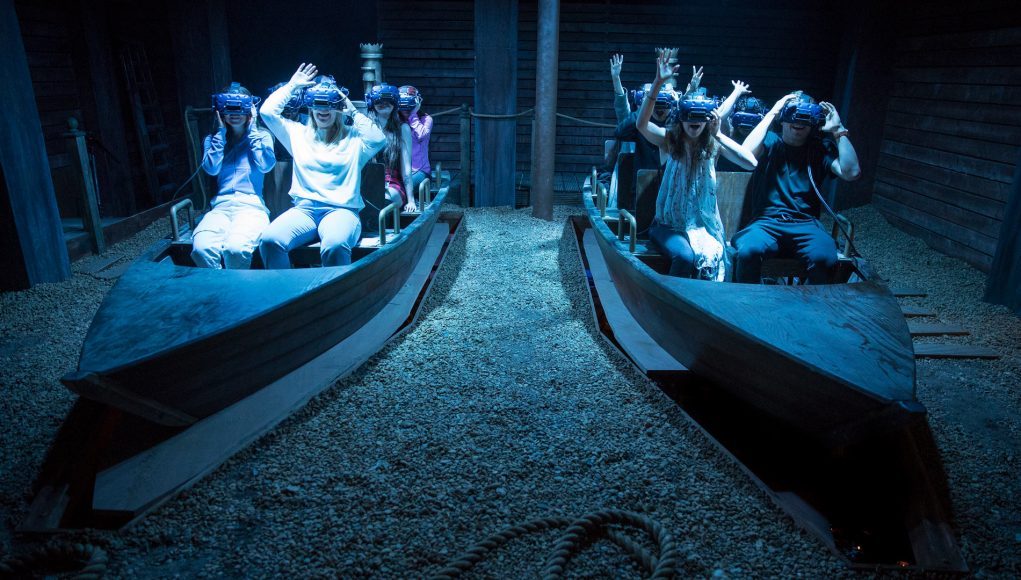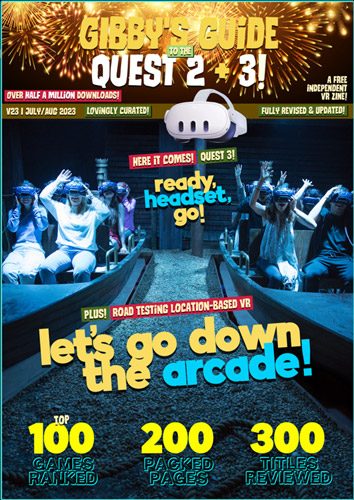Location-based VR has bounced back since the pandemic. So let’s get some arcade action! The fastest-growing company, Sandbox VR, has just opened their 40th location worldwide. Gibby’s Guide went out and about to road test the best that the sector has to offer.
Gibby Zobel is an English-born journalist, filmmaker and radio broadcaster. Based in Brazil for over 20 years, he produces content for the BBC World Service, BBC News and China Global Television Network (CGTN). Currently on sabbatical in the UK, he writes and publishes Gibby’s Guide, a free independent VR digital magazine, launched in 2021.
As fans of Gibby’s work, we share a selection of the magazine’s feature articles, this one from the latest issue: Gibby’s Guide V23.
“I wanted an immersive experience with my friends, where they could reach out and touch each other and actually make a physical connection. I believed that the real magic of VR would begin when someone could totally lose themselves in the immersive experience. The game, the interface, the disbelief would all fall away and only Experience would be left.”
Steve Zhao, co-founder and CEO of Sandbox VR, outlined his vision of a ‘minimum viable matrix’. Then he built it.
WHAT IS LBVR?
Location-based Virtual Reality or LBVR refers to an out-of-home location where people can play unique VR games, usually as a team, that they can’t find on consumer headsets. Haptic vests and physical items like a gun can add to the experience, as can extras like fans, heaters, water spray and hydraulics. Games are purpose built in-house or by studios like Ubisoft.
It began with the opening of their first arena in June 2017 on the 16th floor of a back alley high rise in Hong Kong with leaky pipes, surrounded by private members clubs and other less salubrious neighbours.
Exactly six years later a premium location in downtown Seattle has just become Sandbox VR’s 40th location worldwide—they are present across the US, Europe and Asia—and they are the fastest growing company in the sector.
But it very nearly didn’t happen. Covid-19 threatened to strangle the fledgling LBVR industry at birth. The major player at the time, The Void, sank without trace. Some survived. A case in point is Zhao’s Sandbox VR. He relates the story on his Medium page.
“With a nationwide lockdown and all our retail locations mandated to close, our revenue plummeted by 100%. The year was traumatising for the team and myself: running a near-death startup during the worst crisis possible while undergoing an emotionally taxing bankruptcy process, with the team barely getting paid at all,” he says.
But through a drastic 80% staff cut, rent freezes, and financial contortions they pulled through.
Last month they launched their seventh LBVR title built in-house, Seekers of The Shard: Dragonfire, and have announced a deal with Netflix to bring Squid Game to VR later this year following on from a deal with CBS to make Star Trek Discovery.
While Sandbox VR is undoubtedly the shining beacon, selling upwards of 100,000 tickets a month, other LBVR companies are making headway.
Czech start-up Divr Labs is backed by billionaire Daniel Kretinsky—known for his investment in West Ham United Football Club—and has opened in a prime location in West London inside Westfield, Europe’s largest shopping centre, in addition to venues in Stockholm and Prague.
Clever design means that Divr Labs can accommodate 48 people an hour inside its 150 square metre space. At full capacity that would equate to an income north of $4M a year in just that one retail area.
London’s first VR arcade, DNA VR, has expanded to three venues in the capital and one in Manchester while another UK venture, Meetspace VR has seven arcades across the country.
In the Guandong Province in China, the Lionsgate Entertainment World, which opened in July 2019, is the most technologically advanced theme park on the planet. It leverages popular film franchises like The Hunger Games and The Twilight Saga to create VR experiences including an indoor VR rollercoaster and motorbike sim.
ILMxLAB (now ILM Immersive) similarly held a limited run of Star Wars Tales From The Galaxy’s Edge at Disney World Orlando in 2022.
Back in London, Layered Reality also borrows from popular culture creating a two-hour spectacular with Jeff Wayne’s War Of The Worlds Immersive Experience.
Now in its fourth year, it takes place in a huge purpose-built set. It’s voted the number one immersive experience in the capital on Trip Advisor and has surpassed 175,000 customers.
But what are these experiences like? Do they justify the the hype?
Sometimes LBVR can be a terrible disappointment; recent examples include efforts at high profile arts centres like the Serpentine Galleries and Barbican Centre, which can be fatal to public interest, especially if it is their first time in a headset.
They also have to hold up against competing entertainment options. Traditional arcades have had a renaissance and retro places like NQ64, Arcade Club, and Pixel Bar are popular.
Then there’s the emerging trend of projection mapping with motion tracking.
Immersive Gamebox offers their non-VR version of Squid Game, Ghostbusters, and Angry Birds while Chaos Karts promises “an augmented reality experience without the need for headsets” on their illuminated race tracks.
An LBVR Road Trip
 Gibby’s Guide—that’s me and a bunch of mates—set out to take the temperature of the industry, travelling to five different locations in the UK.
Gibby’s Guide—that’s me and a bunch of mates—set out to take the temperature of the industry, travelling to five different locations in the UK.
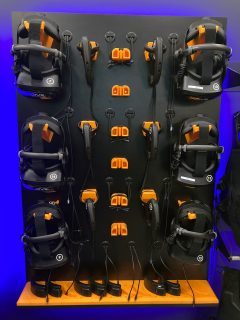 All of us had some level of experience playing with Quest 2 at home but none had been to a LBVR attraction.
All of us had some level of experience playing with Quest 2 at home but none had been to a LBVR attraction.
Clearly this sample is geographically specific but some, like Sandbox VR, can be also found across the US and worldwide and many of the details are common to others.
None of the LBVR venues we visited used Quest 2; various iterations of the HTC Vive (usually the Focus 3) or PiMAX were the headsets of choice at the venues.
Prices varied between the equivalent of $40–$75 per person, and lasted between 25 minutes and two hours. The minimum age requirement began at 7 and went up to 16 depending on the game.
Sandbox VR
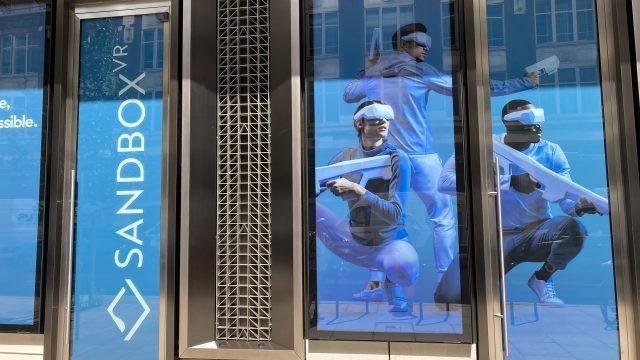 Sandbox VR knows the value of first impressions. The location is prime real estate in central London and the façade of the modern Post Building is unmissable, decked in giant posters of VR gamers with the brand’s logo.
Sandbox VR knows the value of first impressions. The location is prime real estate in central London and the façade of the modern Post Building is unmissable, decked in giant posters of VR gamers with the brand’s logo.
You are greeted by airport-style check-in terminals and a robot cocktail waiter to mix your drinks.
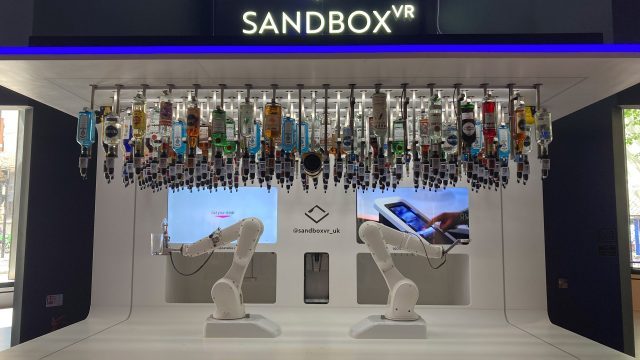 Attendants give you an iPad menu of weapons to chose from (you take the physical item into the arena), snap your photo and lead you in to a loading area. You put on a haptic vest and tie alien-looking velcro trackers that look like atoms around your wrists and ankles for full body real-time motion capture.
Attendants give you an iPad menu of weapons to chose from (you take the physical item into the arena), snap your photo and lead you in to a loading area. You put on a haptic vest and tie alien-looking velcro trackers that look like atoms around your wrists and ankles for full body real-time motion capture.
 You carry a laptop in a backpack that sends movement coordinates to a server. It’s quite a bit of kit, not forgetting the headset itself, and you feel the weight.
You carry a laptop in a backpack that sends movement coordinates to a server. It’s quite a bit of kit, not forgetting the headset itself, and you feel the weight.
I’m playing Dead Wood Valley with Jonny. We often play multiplayer games on Quest 2 from separate houses but this is our first co-location VR experience (ie: occupying the same physical playspace).
The street is filled with zombies and vultures. It’s loud. We can’t hear each other over the sound of our gunfire which starts from the get-go and only relents after we defeat the final boss.
25 minutes later. We’ve flown on a chopper, ridden on a truck and saved each other several times from certain death (you have to physically touch the shoulder of your teammate to revive them).
At the end of the experience it’s time to party on a lit up dancefloor to record one of a couple of videos ripe for social media that hot swap from you in the VR gear in the room to the virtual world.
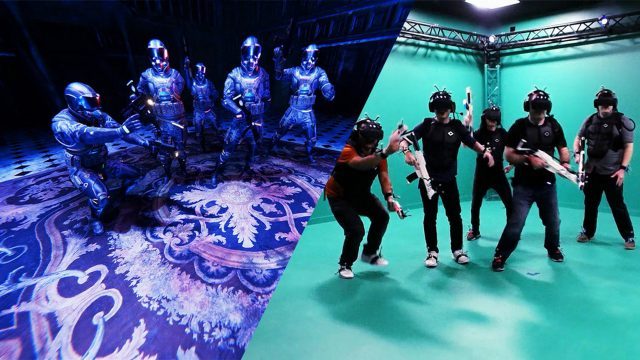 “Overall I’m a little underwhelmed,” says Jonny. “The game itself looked good, sounded good, but what you actually do is quite limited.”
“Overall I’m a little underwhelmed,” says Jonny. “The game itself looked good, sounded good, but what you actually do is quite limited.”
“You are just shooting, you don’t really have time to communicate, the room was quite small. It reminded me of one of those old arcade games where you’d have the gun and the foot pedal to duck down and hide behind things but upscaled into a VRscape.”
“I liked the haptic suit and the feedback on the gun. When I had to touch you on the shoulder it felt disorientating.”
“I guess for people who have never done VR before or in a group it’s something fun to do, like going bowling.”
“I’m glad I’ve done it, I would recommend that people have a go. It’s a little overpriced but then I’m notoriously tight-fisted!”

